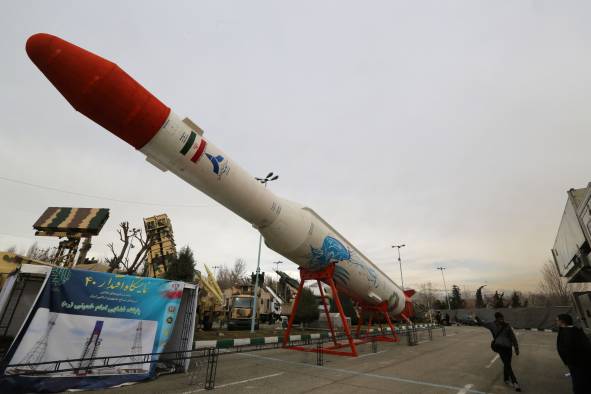Iran’s Nuclear Clock is Ticking Once Again. Here’s How to Stop It
 In a move that could significantly shorten its path to a bomb, Iran announced another expansion of its nuclear activities starting Sunday in breach of the Joint Comprehensive Plan of Action (JCPOA). As its foreign minister intimated, this could be part of a larger “counter-pressure” strategy to roll back more nuclear caps unless the deal’s remaining parties offset U.S. sanctions. With Tehran’s demanded relief nowhere in sight, the United States must assume time is again running out to prevent a nuclear Iran.
In a move that could significantly shorten its path to a bomb, Iran announced another expansion of its nuclear activities starting Sunday in breach of the Joint Comprehensive Plan of Action (JCPOA). As its foreign minister intimated, this could be part of a larger “counter-pressure” strategy to roll back more nuclear caps unless the deal’s remaining parties offset U.S. sanctions. With Tehran’s demanded relief nowhere in sight, the United States must assume time is again running out to prevent a nuclear Iran.
In a new report, the Iran Policy Project at the Jewish Institute for National Security of America (JINSA) assesses how these moves affect “breakout time” estimates for producing one nuclear weapon’s worth of fissile material. We also assess the impacts of further steps it could take.
On May 8 President Rouhani declared Iran would exceed the agreement’s ceilings on low enriched uranium (LEU) and heavy water stockpiles. He then gave Europe, Russia and China sixty days for sanctions relief, otherwise Iran would enrich LEU above the current 3.67 percent and abandon the JCPOA-approved redesign of its heavy water reactor.
Increasing this uranium stockpile could shrink Iran’s breakout time steadily and significantly, but not precipitously, from approximately 11 months today to roughly 7-8 months a year from now. Growing the heavy water stockpile by itself will not advance Iran’s ability to produce weapon-grade plutonium, since there is no completed reactor.
However, Iran could achieve a bomb sooner by also fulfilling Sunday’s promise to enrich uranium to higher purity. Despite the much greater difference in enrichment level, jumping from 3.67 to the 90 percent needed for a nuclear device requires only half the time of reaching 3.67 percent in the first place.
Depending how much capacity Iran used, a year from now its estimated breakout window could be 2-3 months—potentially small enough where inspectors would struggle to detect it.
Meanwhile, Sunday’s decision to rebuild the original heavy water reactor puts Iran back on track to eventually produce multiple bombs’ worth of plutonium annually. This would require reconstruction before the reactor could go critical, likely taking longer than the uranium route.
Combined, these escalations indicate where Tehran could seek to apply additional pressure by moving even closer to nuclear weapons capability – most effectively and readily by re-expanding uranium enrichment capacity.
Here Iran’s likeliest and most feasible options would be to reinstall and operate centrifuges removed by the JCPOA, including more productive machines than it currently operates, and to restart uranium enrichment at Fordow—as Iran has suggested. Though less probable for cutting breakout time quickly, it also could attempt to deploy advanced IR-6 and IR-8 centrifuges currently limited to research and development.
These prospective moves could reduce Iran’s breakout time immediately, to roughly 5-6 months, rather than reduce it steadily over time like the measures initiated Sunday.
Whereas all these uranium advancements cut breakout time cumulatively, Iran’s next moves down the plutonium path likely would proceed in parallel. Its clearest pressure tactic would be to insert a duplicate of the original fuel tubing into the heavy water reactor core. Though Iran rendered the initial tubing unusable as per the nuclear agreement, its officials acknowledged secretly procuring backups beforehand to re-enable fissile material production.
Simultaneously, Iran could practice reprocessing spent reactor fuel, ostensibly for medical purposes. Such work, which it previously conducted illegally, would strongly suggest intentions to produce plutonium once the reactor becomes operational and irradiates enough fuel. More generally, given Iran’s lengthy record of violating nuclear safeguards, the possibility of ongoing covert activities cannot be overlooked.
The more these activities occur, the better chance of detection. Accordingly, Iran could also stop implementing its nuclear safeguards wholly or in part, or even withdraw from the JCPOA or the Non-Proliferation Treaty (NPT).
Indeed, Iran’s portrayal of its latest actions as bargaining chips should not obscure the fundamental fact—underscored by recent threats to leave the NPT—that its nuclear ambitions never were peaceful. For Tehran the JCPOA was meant to achieve sanctions relief and international recognition of its nuclear program while paving the way to the bomb.
With that deal potentially unraveling as Iran makes its next moves, the United States should make its own. Credible military threats have successfully shaped Tehran’s behavior previously and could compel it to modulate the acceleration of its nuclear program.
The United States should prepare credible options to deter or deny Tehran from achieving an undetectable nuclear breakout capability, including viable contingency plans and military exercises for neutralizing Iran’s nuclear facilities and missiles, increased forward U.S. military posture and concerted coordination with regional allies to defend against Iranian retaliation.
President Rouhani says repeatedly these JCPOA violations can be reversed. To help convince Tehran that would be the correct next step, first and foremost American policymakers must be ready to prevent a nuclear Iran before time runs out.
Former Undersecretary of Defense for Policy Ambassador Eric Edelman co-chairs the Iran Policy Project at the Jewish Institute for National Security of America (JINSA), where Michael Makovsky, a former Pentagon official, and Jonathan Ruhe are CEO and Associate Policy Director, respectively.
Originally published in Newsweek